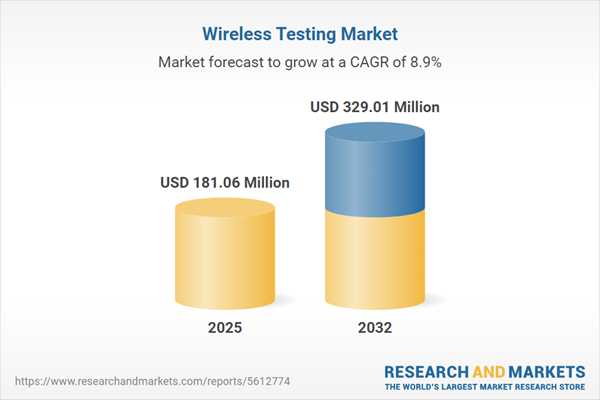Speak directly to the analyst to clarify any post sales queries you may have.
The wireless testing market is increasingly critical for organizations seeking to safeguard network security, maintain compliance, and support seamless operations amidst accelerating digital transformation. As enterprises adapt to new technologies and shifting regulatory demands, strategic wireless testing provides the clarity and assurance needed to manage risk and drive business continuity.
Market Snapshot: Wireless Testing Market Size and Growth
In 2024, the global wireless testing market is valued at USD 166.06 million, with projections indicating growth to USD 181.06 million by 2025 and USD 329.01 million by 2032. This represents a compound annual growth rate of 8.92%. The upward trajectory is powered by rapid investment in advanced wireless technologies, increasing requirements for secure infrastructure, and growing demand for enterprise-wide connectivity solutions. Senior decision-makers are leveraging wireless testing to ensure operational reliability as their organizations adjust to emerging compliance frameworks and evolving digital strategies.
Scope & Segmentation of the Wireless Testing Market
This comprehensive segment analysis equips executives with the frameworks needed to select and implement wireless testing solutions that align with business priorities:
- Technology: Established and next-generation wireless protocols, such as 5G, Wi-Fi, and Bluetooth, form the backbone of modern enterprise networks, supporting high-speed data exchange and reliability.
- Solution Type: The market comprises platforms for validation, protocol conformance, network emulation, and drive testing, each essential for ensuring robust network performance from initial design to live deployment.
- Service Type: Offerings span consulting, hardware evaluation, and software-based test services, facilitating proactive compliance management, technical troubleshooting, and ongoing optimization of network resources.
- Application: Use cases range from automotive connectivity and IoT deployments to defense systems, public safety networks, and consumer electronics, with each demanding specific levels of security and regulatory compliance.
- End User: Solutions are tailored for enterprises, telecommunications carriers, government agencies, and network service providers, each segment needing performance validation and enhanced security controls.
- Deployment Mode: Wireless testing is conducted in laboratory, field, or cloud-based settings, with simulation and real-time monitoring capabilities enabling continuous performance assessment in diverse environments.
- Region: The market spans the Americas, Europe, Asia-Pacific, and the Middle East & Africa, reflecting differences in technology maturity, regulatory requirements, and logistical conditions that influence adoption strategies.
- Key Companies: Leading players include Keysight Technologies Inc., Rohde & Schwarz GmbH & Co. KG, Anritsu Corporation, Spirent Communications plc, and Viavi Solutions Inc., providing vital technologies across global markets.
Key Takeaways for Senior Decision-Makers
- Cloud-based and software-driven wireless testing enhances enterprise agility, enabling fast adaptation to evolving connectivity and compliance mandates.
- Integrating artificial intelligence and machine learning supports rapid identification of security vulnerabilities and allows enterprises to anticipate operational risks.
- Modular compliance solutions streamline auditing processes, maintaining high operational standards as regulations shift.
- Regional requirements influence deployment approaches; priorities for automation, interoperability, and localized solutions vary by geography and standards landscape.
- Strong collaboration between solution vendors, chipset suppliers, and cloud providers ensures cohesive platforms that help organizations satisfy technical and regulatory challenges.
- Professional consulting and advanced validation enable enterprises to respond flexibly to regulatory changes and increasing network complexity.
Tariff Impact: Navigating Trade Policy Shifts
Adjustments to U.S. tariffs on wireless testing equipment and semiconductor parts are influencing purchasing and sourcing strategies throughout the industry. To mitigate these impacts, organizations are strengthening regional assembly and logistics partnerships while accelerating validation earlier in project timelines. These measures protect access to vital components and bolster supply chain resilience during periods of trade uncertainty.
Wireless Testing Market Methodology & Data Sources
The report integrates direct insights from network operators, solution providers, and technical experts. These firsthand findings are enhanced by secondary analysis of published research and performance data, ensuring robust, actionable intelligence for executive-level wireless strategy decisions.
Why This Report Matters
- Delivers strategic recommendations for selecting wireless testing solutions that support regulatory compliance and infrastructure growth.
- Offers benchmarks enabling senior leaders to evaluate investment opportunities, address potential risks, and align network initiatives with business objectives.
- Keeps decision-makers updated on the changing dynamics of technology, compliance, and wireless testing to foster enterprise continuity and innovation.
Conclusion
Wireless testing empowers organizations to build resilient and secure networks that meet evolving business and compliance needs. This report gives executives critical insight to guide future-focused technology adoption.
Additional Product Information:
- Purchase of this report includes 1 year online access with quarterly updates.
- This report can be updated on request. Please contact our Customer Experience team using the Ask a Question widget on our website.
Table of Contents
3. Executive Summary
4. Market Overview
7. Cumulative Impact of Artificial Intelligence 2025
Companies Mentioned
The companies profiled in this Wireless Testing market report include:- Keysight Technologies Inc.
- Rohde & Schwarz GmbH & Co. KG
- Anritsu Corporation
- Spirent Communications plc
- Viavi Solutions Inc.
- EXFO Inc.
- National Instruments Corporation
- Cobham plc
- Chroma ATE Inc.
- AEM Holdings Ltd.
Table Information
| Report Attribute | Details |
|---|---|
| No. of Pages | 189 |
| Published | October 2025 |
| Forecast Period | 2025 - 2032 |
| Estimated Market Value ( USD | $ 181.06 Million |
| Forecasted Market Value ( USD | $ 329.01 Million |
| Compound Annual Growth Rate | 8.9% |
| Regions Covered | Global |
| No. of Companies Mentioned | 11 |









